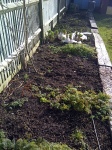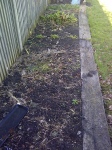“A garden is a grand teacher. It teaches patience and careful watchfulness; industry and thrift; above all entire trust. Gertrude Jekyll 1843-1932.”
- South-Easterly Aspect
- Mid-South-Westerly Aspect
So here we are, pictures of my two rather sad looking vegetable plots – they sit opposite each other toward the rear of our south facing garden. I know I am very lucky to have two.
Plot A, 6 meters x 1 1/2 meters approx., runs parallel to the south-east fence, and as you can imagine, gets lots of sun during our long summer days; from mid-morning until the sun finally takes it leave from the very farthest southern tip in the late evening. I have found that the couple of things I have planted here have had no problem establishing and if I had taken a little more care of them would have flourished wonderfully for me!
Last year I loosely divided the bed into three and the plan was to grow root vegetables in the first, most northerly section, cabbages in the middle section and peas and beans in the most southerly section. This way the beans would not be blocking the sunlight to the rest of the bed in the later part of the day. My plan fell to bits due to lack of motivation on my part (ok – I did give birth so was a little distracted…..) but I don’t want to make excuses!
As I mentioned earlier, Plot B sits on the opposite fence, the south-west. It is slightly smaller that Plot A at 5 meters by 1 meter approx. In the winter, the light is very feeble and it looks incredibly sad. In the summer it gets the very first of the suns rays and enjoys the sunlight right through until early afternoon when the sun passes the yard-arm (wonderful english expression!) However, I suspect that I wont be able to grow anything that requires lots of light. Quite a limiting factor in gardening!
Last year I planted a courgette (zucchini) and a cucumber here. Neither of these did very well and with hindsight it was not a good place to plant them. They obviously both need lots of light (maybe their large leaves should have warned me?) and they just didn’t get enough there. The salad leaves that I planted at the north end of the plot did do ok and I think that I am going to have to dedicate this plot henceforth to plants of the leafy salad variety.
My plan now is to weed and generally clean up the plots in preparation for the coming growing season. But I am unsure what I should do about enriching the soil? Both plots had a good lot of muck added in their first year, and last year each had quite a good amount of compost from our home ‘grown’ compost bin. Is that sufficient for this year? I have a sneaking suspicion I should be forking in something but am worried that I should have done it in the autumn, as anything I add now will not have time to break down before I need to start planting in a month or so. Any advice on this score? It would be greatly appreciated.
Let’s see what gardening joys the upcoming week brings. I will be sure to tell you about them in my next post!
Simone.


Good job, Simone! Your plots are GREAT! From what I’ve read: pumpkin, lettuce, and some herbs do well in “part-shade” so for what that’s worth, there ya’ go!
What part of England are you in? In our county (Arlington) leaf or bark mulch is delivered for a small fee and that’s what I’m churning into my dirt. Do you have a similar service? Yes, I would amend the soil again. In *every single one* of my 15+ gardening books there is a HUGE section on soil amendment. But what I learned (too late) was that fall is the best time to amend, but if you’re amending in the spring, better late than never.
Thank you for sharing your photos!
Thank you Gardener Faith.
Love your tips/advice – just what I am hoping for. Pumpkin, herbs and lettuce – ok will remember that.
Leaf mould is a great idea – I’m in Sussex and I’m sure we can get it delivered. That would be great for the soil. Will look into it.
Yes, I thought I had left it a bit late, but I shall get on to enriching the soil next week.
Thanks so much for the comment. Greatly appreciated.
Yup – good luck. Just make sure that you get the herbs that can tolerate a little shade, like parsley. The Mediterranean herbs like rosemary, basil, thyme, and sage need A LOT of sun, and sandy soil, so make sure not to confuse those growing requirements.
GOOD LUCK! And can’t wait to see how it turns out.
Thanks!
it is good to add a layer of compost to all your gardenbeds every year. you can´t overdo compost and it is ok to add it in early spring. additionaly i would add manure to all the plants that need a lot of fertilizer and can cope with it ie. courgettes, tomatoes, cucumbers, corn, pumpkins etc. add fresh manure in atumn or half composted manure in spring. if you rotate the heavy feeders you will add manure to different parts of your garden every year. during the summer you can use liquid fertiliser like nettle tea. i will probably write an article about it some time:-)
if you plant runner beans along the fence in a long row, they will not shade your other plants. scarlett runner beans(the big pink ones with the black dots) will probably be ok on the shadier side. if the grow up the fence the get more sunlight as well. happy gardening
Thank you commonredstart. I will definately make a note to remember to manure in the autumn this year. And as I replied to Gardener Faith, I will get some leaf mould or something similar in this week. So much to do! Good idea to get manure for the heavy feeders.
Tell me, my neighbours tomatoes suffer from blight each year. So it has put me off growing them – do you have any advice?
Thank you so much for your comments.
well, the neighbours blight tells you that the situation is not ideal for growing tomatoes. that doesn´t mean there is no point in trying. blight develops when it is wet and cool. the tomatoes like it warm hot and dry. so the trick is to manipulate the situation towards the tomato side. if you grew the plants on the warm and sunny side in front of the fence and maybe attach a little plastic roof of some sort to the fence you could give it a go. we have to battle blight every year. you just have to make sure you get a crop of tomatoes before the blight gets your plants.
further things you could do:
grow several varieties, some will do better
grow early varieties with a lot of small tomatoes
train the tomatoes to grow one vine per plant they dry quicker and get more air that way.
space the plants appart to allow good air circulation.
keep the toamatoe leaves dry. pick the bottom leaves, water only the ground and mulch the ground around the tomatoes with straw to avoid splashing.
start tomatoe seedlings indoors now, so you can plant them out after the risk of frost is over.
happy planting
Thank you for your advice commonredstart, I will give them a go this year and take on board your advice. Will let you know how I get on.
Pingback: The Planting Plan « howdoesmyvegetablegardengrow